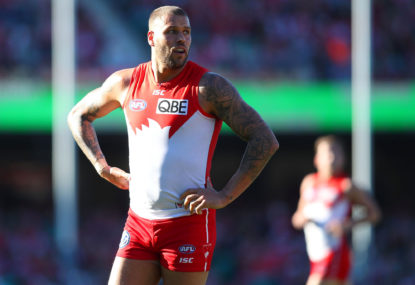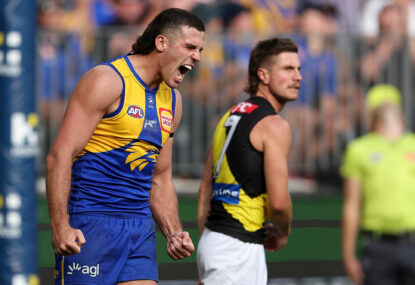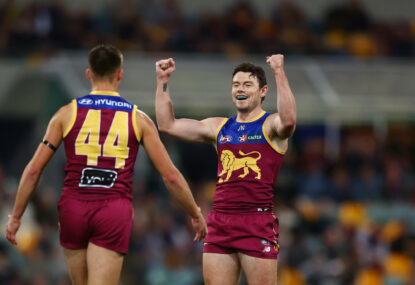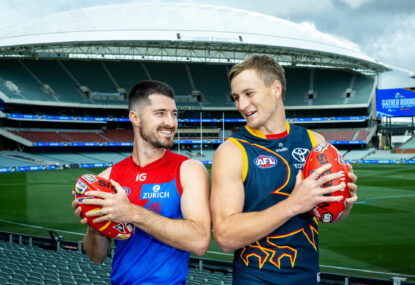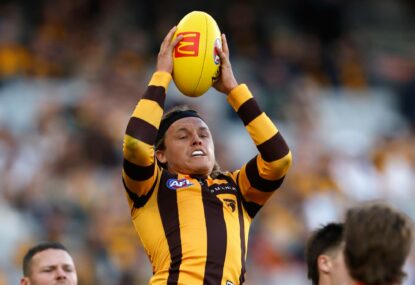The Gold Coast Suns’ victory over the Sydney Swans on Saturday afternoon was a fascinating study in emotions.
The anger of the Sydney fans, the amazement of the announcers, the resignation of the players in red, the exhilaration of the players in white.
On every layer of media, the suggestion was earnestly made that it was the biggest upset of the season. Judging purely from numbers, it’s hard to argue.
By wagering standards, the largest favourites to lose this season were 32-point preferences Geelong in Round 9 and West Coast in Round 14 (Essendon beat the Cats 84-50 at the MCG and 80-52 at Optus), Adelaide as a 33-point choice over Collingwood in Round 4 (back before we knew the Pies were good, 106-58), 30-point favourites Geelong in Round 15 (the Bulldogs upset them 103-101), and most significantly 38-point leader Melbourne that same round facing the Saints (who won 119-117).
Sydney themselves had a similar loss to the Kangaroos, also at the SCG, back in Round 7 by two points, after coming in as 35-point favourites.
Gold Coast were a 52-point underdog to the Swans on Saturday afternoon.
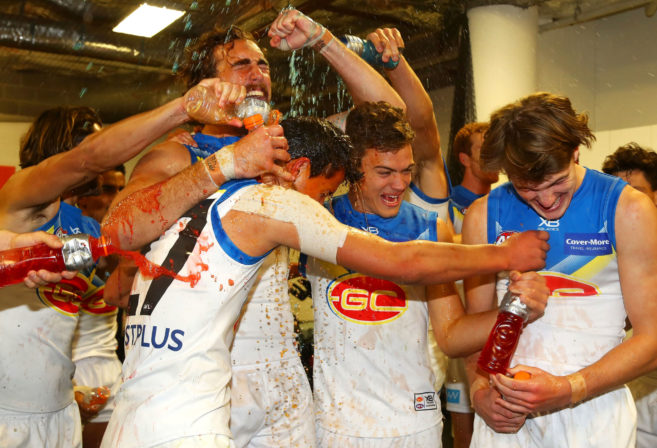
(Photo by Mark Kolbe/Getty Images)
Using our ELO-Following Football rating system, they were 58-point underdogs; the victory was one of only four games so far this season to reach the circuit-breaker we’ve installed in the system for tremendously aberrant results.
Two of those games were Melbourne’s resounding century-sized thumpings of Carlton and Adelaide in rounds nine and ten, but they were slight favourites in both situations.
The other game was indeed an upset. Brisbane’s first win over Hawthorn, but they were no fifty-point underdogs: it was more the 56-point margin of victory over the 25-point favourites in Round 9 at the Gabba bringing our circuit-breaker into play. So yes, it seems likely the Suns have affected the largest upset of the year.
It wasn’t just the victory itself which astounded the viewers and frustrated the Sydney audience (on Swans Fan appreciation day, no less!), but the way it happened. Sydney led the game 32-5 before Touk Miller had the opening goal for the Gold Coast late in the first quarter. They led 41-11 early in the second when Lance Franklin missed the first of his three strikes at goal for the day.
Over the next two quarters, Sydney never found the big sticks. In fact, after scoring forty points in the first quarter, they went 2.12.24 for the last ninety minutes, while their opponents scored 11.11.77 to break an 11-game losing streak and notch their fourth win of the season.
As it became clear it was a study of emotions, it also became clear it was also a study in the gradually increasing confidence of Stuart Dew’s relatively young crew. Once Aaron Young began the comeback with a pair of second-quarter goals, you could see the glimmer of hope appear in the Gold Coast Suns eyes.
It’s instructive to compare the circumstances of each of small forward Alex Sexton’s three goals for Gold Coast. In the first situation, halfway through the second term, Sexton moved his team within six points of the leaders, and the sense was growing that for the moment, Gold Coast would at least be competitive.
When his second goal moved the Suns into their first lead before the end of the first half, you could see they were beginning to dream of actually being there at the game’s conclusion.
There were no goals during the entire opening half of the third quarter, stretching Sydney’s ongoing drought to a quarter and a half. When Sexton nailed his third goal, giving the Gold Coast a 14-point lead while the Swans hadn’t scored 14 points since the first, even the most pessimistic Suns fan could start to believe that this was the day their usual fourth-quarter fade wouldn’t prevent them from waging the upset.
Sure enough, once the Suns answered the early fourth quarter goals from Papley and Parker with another from Aaron Young, the two clinching goals by Weller and Holman sent the local fans heading for the exits and the PA announcer scrambling to find a copy of the Gold Coast theme song to play.
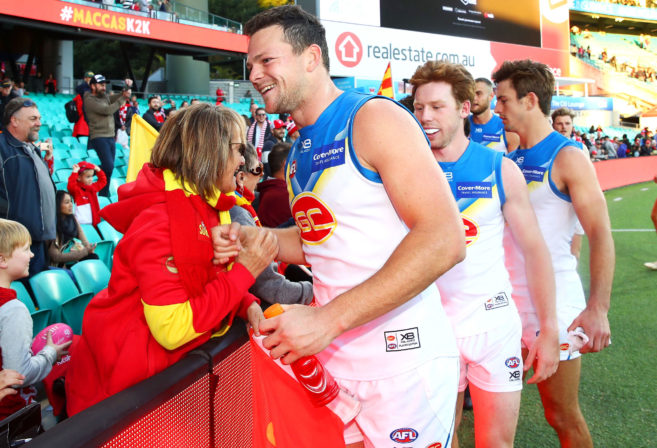
(Photo by Mark Kolbe/Getty Images)
If we extend our view beyond 2018, the obvious candidate for a bigger upset would be the North Melbourne surprise of a then six and zero Adelaide last season in Tasmania, 145-86, when they famously led the eventual minor premiers at the end of the first quarter 64-0. (Let me type that again in case The Roar accidentally tries to correct that as a typo: North 64, Crows nil.)
Yet, the Crows were only 39-point favourites; the massive turn of fortunes in that first period is what made it such a dramatic upset. People forget Adelaide were a 39-point favourite the very next week at home against Melbourne, who also swamped them by several dozen points – just less melodramatically, that’s all.
Of course, if all we’re talking about are point spreads, there were larger upsets even last year – Adelaide also lost a later game to a four and eight Hawthorn at a 51-point spread, though no one would call the Hawks any miraculous winners along the lines of this weekend’s Suns.
Before that, we must go back to wins nine years ago by a 50/50 Essendon and a 5-14-1 Kangaroos team over a St Kilda team that had won its first 19 games in 2009. I don’t know what the point spreads were back then – my “spreadsheets of death” don’t extend that far back – but I’ve got to assume two teams with percentages below 100 would be major underdogs to a 19-0 team.
Perhaps my favourite historical upset is the season-ending game of 1910, when St Kilda was on the other end of footy society. The original Saints were almost persona non grata over the first years of the VFL, and in 1910 they were one game away from earning their ninth wooden spoon in those first fourteen seasons.
The Saints won just two games over their first six full seasons, and only in season eleven, 1907, did they achieve their initial winning season, going nine and eight. But by 1910, they were back to their losing ways. In fact, on September third, they were zero and 17 for the year, barely keeping their percentage above 60, and scheduled to take on league-leading Carlton at Junction Oval.
Carlton were the dominant club in the league at that time, boasting a 15 and two record going into that final game of the home-and-away season with a percentage over 164 per cent, and having already guaranteed themselves yet another minor premiership.
They had missed out on a fourth consecutive VFL title the previous year when South Melbourne (now Sydney) edged them by two points in the grand final.
So the Blues were bound and determined to regain the championship belt they’d surrendered in ’09, and undoubtedly the Saints looked like a bug to be squashed en route to their semi-finals date with whichever opponent ended up in third place (1st played third, second played fourth, and the prelim final would then match two vs three regardless of results. Don’t ask.).
But on that particular Saturday, the 0-17 Saints led the 15-2 Blues by fourteen points after one quarter of play, 3.2.20 to one goal straight. Most likely, Carlton were resting a few guys before the finals, but not many: looking at the roster for that game, only four of the Blues who suited up for that game had played fewer than half the team’s games in 1910, and without knowing how injuries played into those roster changes, all I can promise was that no more than four were rested by the champs.
And in the second quarter, the Blues scored the only goal of the period, moving within three of the underdog Saints, 3.3.21 to 2.6.18. Regular stars Fred Elliot and Andy McDonald had the two goals for the Blues, and they should have gone into the halftime break confident that what remained of St Kilda’s small lead would be short-lived.
Instead, it was Carlton which would fail to kick a major the rest of the game.
The Saints kicked two more goals in the third quarter to go to the final break sixteen points up, and despite a desperate (and off-target) assault on goal by the Blues, the wooden spoon winners would end the season on a high note, earning their only win of the season by twelve points over the unquestioned best team of the half-decade, 5.6.36 to 2.12.24.
The loss would affect Carlton throughout September. They played a similar game against third-place South Melbourne and lost the semi-final by twelve as well, 10.5.65 to 6.17.53 at the MCG.
As logic would dictate, the losing Blues were automatically seeded into the grand final, while South had to play a preliminary final against second-place Collingwood (winners of their semi), which earned the right to play Carlton by defeating South by eleven.
Carlton then finished a season that started 15-2 on a three-game losing streak, losing the grand final to the Magpies in a similarly unbalanced and poorly-kicked manner, 9.7.61 to 6.11.47.
Therefore, thanks to then-winless Saint Kilda staging the upset of the decade, the three-time champion Carlton Blues finished off an otherwise dominating 1910 season with three straight losses in which they kicked a staggering 14 goals and 40 behinds! Sometimes a bad loss can have a devastating long-term effect.
And sometimes, not so much: After the two losses in 2009, St Kilda won their next three games but lost a competitive grand final to an excellent Geelong team when they kicked 9.14 to the Cats’ 12.8. Similarly, last year’s Adelaide team wasn’t overly affected in the long term by the devastating quarter against North Melbourne: the Crows were still minor premiers and made the grand final as well.

(Photo by Adam Trafford/AFL Media/Getty Images)
So it’s too soon to imagine how Sydney’s upset loss to Gold Coast Saturday will affect the Swans as their last five games approach. They’re still sitting fourth, thanks to their city-mates’ and derby rivals’ defeat of Port Adelaide Sunday, but they’re now one game ahead of ninth, with a percentage lower than that Geelong team sitting just outside the finals.
Doubts creep in when you lay an egg like this – it’s impossible in this “what have you done for me lately?” world to avoid wondering what their next five match-ups (all expected to be more competitive than Gold Coast was assumed to be) will look like.
Essendon went from being two-point dogs to three-point favourites overnight after the Swans’ loss. (Gold Coast went from six to twenty-point preferences over Carlton next week.)
As for Gold Coast, this win has the possibility of simply being a blip in their road to another bottom four finish, the sixth in their eight years of existence. In fact, that’s the probable outcome for the Suns; nothing indicates this is anything more than a moment of happiness amidst a season of hopelessness.
The conversation about the long-term viability of the club will continue; the word “contraction” will not go away just because they won one game along the way. Even Fitzroy won a game in 1996.
But maybe – just maybe – it really will be what Steve Allen wrote six decades ago: “The Start Of Something Big”.
Postscript
How big an upset was this? Looking at the current point spreads for the final five rounds, only three of the remaining 45 games currently threatened the point spread of this game – and all involve Gold Coast as the underdog.
Melbourne in Round 20, Richmond in Round 21 and Geelong on the final weekend of the season all had spreads above fifty as of this week. But, following the Suns victory at the SCG, those spreads all went down three to four points. Only the finale at Geelong still sits above fifty, and that only because of the likelihood of the Cats needing percentage for finals participation.
Personally, I would never tell my team to go after percentage – too often you end up in a dogfight you should never have been in.
Like Sydney did on Saturday.





























































































